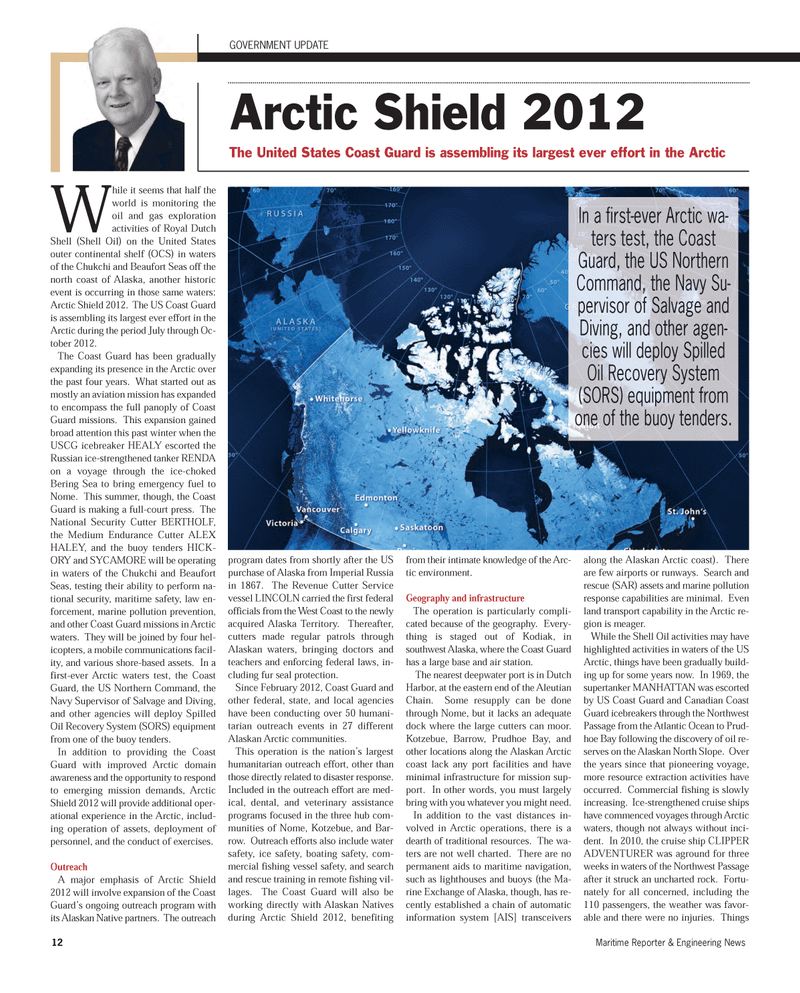
Page 12: of Maritime Reporter Magazine (July 2012)
Arctic Operations
Read this page in Pdf, Flash or Html5 edition of July 2012 Maritime Reporter Magazine
While it seems that half theworld is monitoring the oil and gas exploration activities of Royal Dutch Shell (Shell Oil) on the United Statesouter continental shelf (OCS) in waters of the Chukchi and Beaufort Seas off the north coast of Alaska, another historic event is occurring in those same waters: Arctic Shield 2012. The US Coast Guard is assembling its largest ever effort in the Arctic during the period July through Oc-tober 2012. The Coast Guard has been graduallyexpanding its presence in the Arctic over the past four years. What started out as mostly an aviation mission has expanded to encompass the full panoply of CoastGuard missions. This expansion gained broad attention this past winter when theUSCG icebreaker HEALY escorted the Russian ice-strengthened tanker RENDA on a voyage through the ice-choked Bering Sea to bring emergency fuel to Nome. This summer, though, the Coast Guard is making a full-court press. The National Security Cutter BERTHOLF, the Medium Endurance Cutter ALEX HALEY, and the buoy tenders HICK- ORY and SYCAMORE will be operating in waters of the Chukchi and Beaufort Seas, testing their ability to perform na-tional security, maritime safety, law en- forcement, marine pollution prevention, and other Coast Guard missions in Arctic waters. They will be joined by four hel- icopters, a mobile communications facil- ity, and various shore-based assets. In a first-ever Arctic waters test, the Coast Guard, the US Northern Command, theNavy Supervisor of Salvage and Diving, and other agencies will deploy Spilled Oil Recovery System (SORS) equipment from one of the buoy tenders. In addition to providing the Coast Guard with improved Arctic domain awareness and the opportunity to respond to emerging mission demands, Arctic Shield 2012 will provide additional oper- ational experience in the Arctic, includ- ing operation of assets, deployment of personnel, and the conduct of exercises. Outreach A major emphasis of Arctic Shield 2012 will involve expansion of the Coast Guard?s ongoing outreach program with its Alaskan Native partners. The outreach program dates from shortly after the USpurchase of Alaska from Imperial Russia in 1867. The Revenue Cutter Service vessel LINCOLN carried the first federal officials from the West Coast to the newly acquired Alaska Territory. Thereafter, cutters made regular patrols through Alaskan waters, bringing doctors and teachers and enforcing federal laws, in- cluding fur seal protection. Since February 2012, Coast Guard andother federal, state, and local agencieshave been conducting over 50 humani- tarian outreach events in 27 different Alaskan Arctic communities. This operation is the nation?s largest humanitarian outreach effort, other than those directly related to disaster response.Included in the outreach effort are med- ical, dental, and veterinary assistance programs focused in the three hub com-munities of Nome, Kotzebue, and Bar- row. Outreach efforts also include water safety, ice safety, boating safety, com- mercial fishing vessel safety, and search and rescue training in remote fishing vil- lages. The Coast Guard will also be working directly with Alaskan Natives during Arctic Shield 2012, benefiting from their intimate knowledge of the Arc- tic environment. Geography and infrastructure The operation is particularly compli-cated because of the geography. Every- thing is staged out of Kodiak, in southwest Alaska, where the Coast Guard has a large base and air station. The nearest deepwater port is in Dutch Harbor, at the eastern end of the Aleutian Chain. Some resupply can be donethrough Nome, but it lacks an adequate dock where the large cutters can moor. Kotzebue, Barrow, Prudhoe Bay, and other locations along the Alaskan Arctic coast lack any port facilities and have minimal infrastructure for mission sup-port. In other words, you must largely bring with you whatever you might need. In addition to the vast distances in- volved in Arctic operations, there is a dearth of traditional resources. The wa- ters are not well charted. There are no permanent aids to maritime navigation, such as lighthouses and buoys (the Ma- rine Exchange of Alaska, though, has re- cently established a chain of automaticinformation system [AIS] transceivers along the Alaskan Arctic coast). There are few airports or runways. Search and rescue (SAR) assets and marine pollutionresponse capabilities are minimal. Even land transport capability in the Arctic re- gion is meager. While the Shell Oil activities may have highlighted activities in waters of the US Arctic, things have been gradually build- ing up for some years now. In 1969, the supertanker MANHATTAN was escorted by US Coast Guard and Canadian CoastGuard icebreakers through the Northwest Passage from the Atlantic Ocean to Prud- hoe Bay following the discovery of oil re- serves on the Alaskan North Slope. Over the years since that pioneering voyage, more resource extraction activities have occurred. Commercial fishing is slowly increasing. Ice-strengthened cruise shipshave commenced voyages through Arctic waters, though not always without inci- dent. In 2010, the cruise ship CLIPPERADVENTURER was aground for three weeks in waters of the Northwest Passage after it struck an uncharted rock. Fortu- nately for all concerned, including the110 passengers, the weather was favor- able and there were no injuries. Things GOVERNMENT UPDATE Arctic Shield 2012 The United States Coast Guard is assembling its largest ever effort in the Arctic 12Maritime Reporter & Engineering News In a first-ever Arctic wa- ters test, the CoastGuard, the US Northern Command, the Navy Su-pervisor of Salvage andDiving, and other agen-cies will deploy SpilledOil Recovery System(SORS) equipment from one of the buoy tenders. MR#7 (10-17):MR Template 7/6/2012 10:00 AM Page 12

 11
11

 13
13
